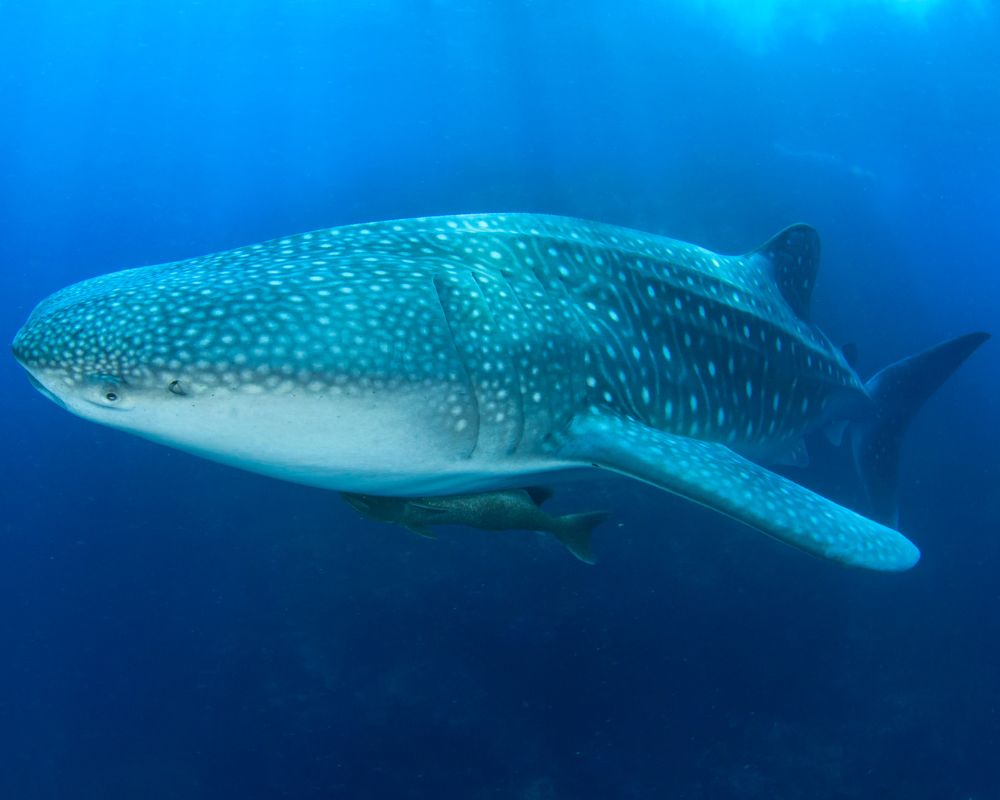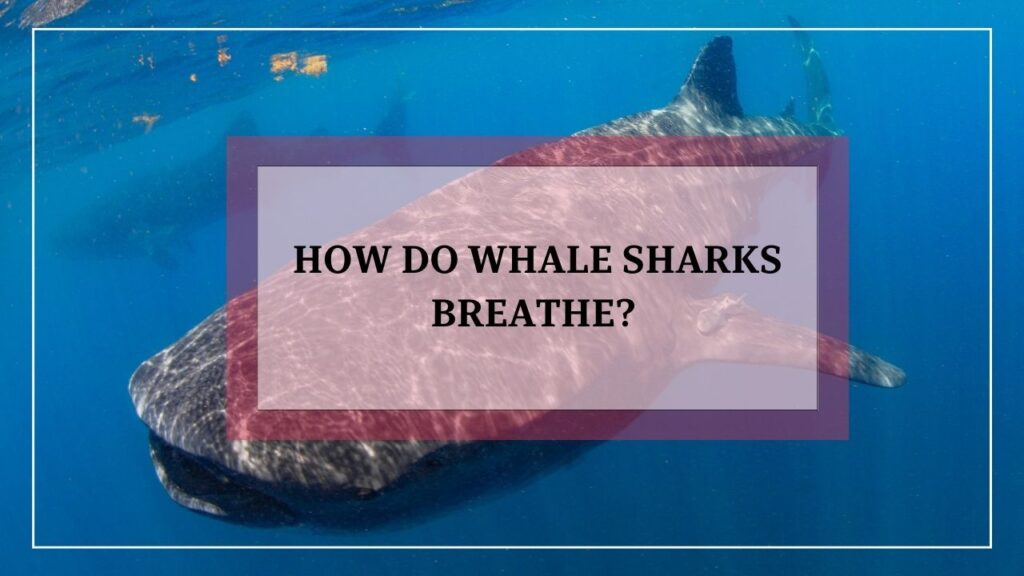Have you ever wondered how the world’s largest fish, the whale shark, is able to breathe underwater? As a creature that can grow up to 40 feet long and weigh more than 20 tons, it’s a fascinating question. Whale sharks are truly magnificent creatures that capture the imagination of marine enthusiasts and casual beachgoers alike.
In this blog post, we’ll explore the breathing mechanism of whale sharks in detail, delving into their unique anatomy and adaptations that allow them to thrive in their aquatic environment. We’ll also discuss the threats that they face from human activities and what can be done to protect these gentle giants.
You may be interested to read this article: The Ultimate Guide to How Great White Sharks Breathe?
Anatomy of Whale Sharks

Whale sharks are the largest fish species in the world, with adults measuring up to 40 feet in length and weighing more than 20 tons. Their size and weight make them an awe-inspiring sight, and their unique anatomy allows them to thrive in their aquatic environment.
Size And Weight
Whale sharks are often compared to whales due to their size, but they are actually part of the shark family. They are filter feeders that consume large quantities of plankton, krill, and small fish. Despite their massive size, they have tiny teeth only used to filter food from the water.
The average adult whale shark measures around 25 feet in length and weighs around 20,000 pounds. However, some individuals have been known to grow up to 40 feet in length and weigh as much as 41,000 pounds.[1]
Respiratory System
Whale sharks have a complex respiratory system that allows them to extract oxygen from water. Like other fish, they use gills to breathe, but they also have a unique adaptation called spiracles. Spiracles are small holes located behind the eyes that allow the shark to take in water without having to open its mouth.
Once the water enters the spiracles, it passes over the gills, where oxygen is extracted and carbon dioxide is removed. The oxygen-rich blood is then pumped throughout the body by the heart, allowing the shark to swim and carry out other vital functions.
In addition to their respiratory system, whale sharks also have other adaptations that allow them to thrive in their aquatic environment. In the next section, we’ll explore the unique breathing mechanism of whale sharks in more detail.
Breathing Mechanism of Whale Sharks
Whale sharks have a unique breathing mechanism that allows them to extract oxygen from water. Let’s take a closer look at how they breathe.
1. Gills And Spiracles
Like other fish, whale sharks have gills that extract oxygen from water. However, they also have a unique adaptation called spiracles. Spiracles are small holes located behind the eyes that allow the shark to take in water without having to open its mouth.
Once the water enters the spiracles, it passes over the gills. The gills are lined with tiny filaments that extract oxygen from the water and release carbon dioxide. The oxygen-rich blood is then carried throughout the body by the circulatory system.
2. Filtration Process
Whale sharks are filter feeders, which means they consume large quantities of plankton, krill, and small fish. To do this, they open their mouth wide and suck in large amounts of water. As the water passes over their gills, they extract the food and release the excess water through their gill slits.
During respiration, a similar filtration process occurs. As water enters the spiracles, it is filtered by small hair-like structures called cilia. The cilia trap any debris or particles in the water and prevent them from entering the gills. This ensures that the gills remain clear and are able to extract oxygen efficiently.
3. Spiracles
Spiracles play a crucial role in the breathing mechanism of whale sharks. Unlike other sharks, they have five pairs of spiracles located on the top of their head. These spiracles allow the shark to take in water even when their mouth is closed. This is especially useful when feeding, as they can continue to consume food without pausing to breathe.
In addition, the spiracles allow the shark to regulate its buoyancy. By taking in water through the spiracles and releasing it through the gill slits, the shark can adjust its weight and maintain its position in the water column.
Adaptations for Aquatic Environment
Whale sharks have a range of adaptations that allow them to thrive in their underwater environment. Let’s take a closer look at these adaptations.
1. Breathing Underwater
Whale sharks are able to breathe underwater thanks to their gills and spiracles, which allow them to extract oxygen from water. In addition, their respiratory system is highly efficient, allowing them to take in large amounts of water and extract oxygen quickly.
Another adaptation that helps whale sharks breathe underwater is their ability to slow down their metabolism. By reducing their energy needs, they can stay underwater for extended periods without needing to surface for air.
2. Regulating Buoyancy
Whale sharks are able to regulate their buoyancy thanks to their large liver. The liver is filled with oil that is less dense than water, which allows the shark to stay afloat without having to use as much energy. By adjusting the amount of oil in their liver, they can control their buoyancy and maintain their position in the water column.
3. Lateral Line
The lateral line is a sensory organ that runs along the length of a shark’s body. It is made up of a series of small pores that contain hair-like structures called neuromasts. These neuromasts are able to detect vibrations and changes in water pressure, allowing the shark to sense movement in the water around them.
Whale sharks use their lateral line to detect prey and navigate through their environment. By sensing changes in water movement, they can locate schools of fish or other prey items and move toward them.
Comparison with Other Sharks Breathing
Whale sharks have a unique breathing mechanism compared to other shark species. Let’s take a closer look at how their breathing differs and what impact it has on their behavior and survival.
Other shark species have a similar breathing mechanism, but there are some key differences. For example, some shark species have to constantly swim with their mouths open to keep water flowing over their gills, while others have to actively pump water over their gills.
Whale sharks, on the other hand, have a passive breathing mechanism. They are able to take in water and extract oxygen without having to actively pump water over their gills or swim with their mouths open. This allows them to conserve energy and stay in one location for extended periods while they feed or rest.
Impact On Behavior And Survival
The unique breathing mechanism of whale sharks has an impact on their behavior and survival. Because they are able to conserve energy while breathing, they can spend more time feeding and resting without having to surface for air.
However, this also makes them vulnerable to threats such as fishing nets and pollution. Because they are not constantly swimming and actively breathing, they can become entangled in fishing nets or ingest pollutants that are floating in the water.
FAQs
How Long Can A Whale Shark Hold Its Breath?
Whale sharks do not actually hold their breath in the way that humans do. Instead, they extract oxygen from the water as it passes over their gills. Because they have a passive breathing mechanism, they can stay underwater for extended periods without needing to surface for air.
Can Whale Sharks Breathe Without Moving?
Yes, whale sharks can breathe without moving. Their passive breathing mechanism allows them to extract oxygen from the water even when they are not swimming or actively pumping water over their gills.
Do Great Whale Sharks Have Lungs?
No, whale sharks do not have lungs. They are able to extract oxygen from the water through their gills and do not require lungs like terrestrial animals do.
Do Whale Sharks Go Up For Air?
No, whale sharks do not need to go up for air like marine mammals such as whales or dolphins. Their passive breathing mechanism allows them to extract oxygen from the water without needing to surface for air. However, they do need to swim in order to keep water flowing over their gills and extract oxygen.

